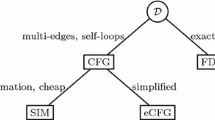Abstract
We review the approaches that model a set of Attributed Graphs (AGs) by extending the definition of AGs to include probabilistic information. As a main result, we present a quite general formulation for estimating the joint probability distribution of the random elements of a set of AGs, in which some degree of probabilistic independence between random elements is assumed, by considering only 2nd-order joint probabilities and marginal ones. We show that the two previously proposed approaches based on the random-graph representation (First-Order Random Graphs (FORGs) and Function-Described Graphs (FDGs)) can be seen as two different approximations of the general formulation presented. From this new representation, it is easy to derive that whereas FORGs contain some more semantic (partial) 2nd-order information, FDGs contain more structural 2nd-order information of the whole set of AGs. Most importantly, the presented formulation opens the door to the development of new and more powerful probabilistic representations of sets of AGs based on the 2nd-order random graph concept.
Chapter PDF
Similar content being viewed by others
Keywords
These keywords were added by machine and not by the authors. This process is experimental and the keywords may be updated as the learning algorithm improves.
References
R. Alquézar, F. Serratosa, A. Sanfeliu, “Distance between Attributed Graphs and Function-Described Graphs relaxing 2nd order restrictions”. Proc. SSPR’2000 andSPR’ 2000, Barcelona, Spain, Springer LNCS-1876, pp. 277–286, 2000.
S. Peleg and A. Rosenfeld, “Determining compatibility coefficients for curve enchancement relaxation processes”, IEEE Transactions on Systems, Man and Cybernetics, vol. 8, pp. 548–555, 1978.
Sanfeliu, F. Serratosa and R. Alquezar, “Clustering of attributed graphs and unsupervised synthesis of function-described graphs”, Proceedings ICPR’2000, 15 th Int. Conf. on Pattern Recog., Barcelona, Spain, Vol. 2, pp. 1026–1029, 2000.
K. Sengupta and K. Boyer, “Organizing large structural modelbases”, IEEE Trans. on Pattern Analysis and Machine Intelligence, vol. 17, pp. 321–332, 1995.
F. Serratosa, R. Alquezar and A. Sanfeliu, “Efficient algorithms for matching attributed graphs and function-described graphs”, in Proceedings ICPR’2000, 15 th Int. Conf. on Pattern Recognition, Barcelona, Spain, Vol. 2, pp. 871–876, 2000.
A.K.C. Wong and M. You, “Entropy and distance of random graphs with application to structural pattern recognition”, IEEE Trans. on PAMI., vol. 7, pp. 599–609, 1985.
H. Bunke, “Error-tolerant graph matching: a formal framework and algorithms”. Proc. Workshops SSPR’98 & SPR’98, Sydney, Australia, Springer LNCS-1451, pp. 1–14, 1998.
D.S. Seong, H.S. Kim & K.H. Park, “Incremental Clustering of Attributed Graphs”, IEEE Transactions on Systems, Man and Cybernetics, vol. 23, pp. 1399–1411, 1993.
Sanfeliu, R. Alquézar, J. Andrade, J. Climent, F. Serratosa and J. Vergés, “Graph-based Representations and Techniques for Image Processing and Image Analysis”, Pattern Recognition, vol. 35, pp: 639–650, 2002.
Author information
Authors and Affiliations
Editor information
Editors and Affiliations
Rights and permissions
Copyright information
© 2002 Springer-Verlag Berlin Heidelberg
About this paper
Cite this paper
Serratosa, F., Alquézar, R., Sanfeliu, A. (2002). Estimating the Joint Probability Distribution of Random Vertices and Arcs by Means of Second-Order Random Graphs. In: Caelli, T., Amin, A., Duin, R.P.W., de Ridder, D., Kamel, M. (eds) Structural, Syntactic, and Statistical Pattern Recognition. SSPR /SPR 2002. Lecture Notes in Computer Science, vol 2396. Springer, Berlin, Heidelberg. https://doi.org/10.1007/3-540-70659-3_26
Download citation
DOI: https://doi.org/10.1007/3-540-70659-3_26
Published:
Publisher Name: Springer, Berlin, Heidelberg
Print ISBN: 978-3-540-44011-6
Online ISBN: 978-3-540-70659-5
eBook Packages: Springer Book Archive





